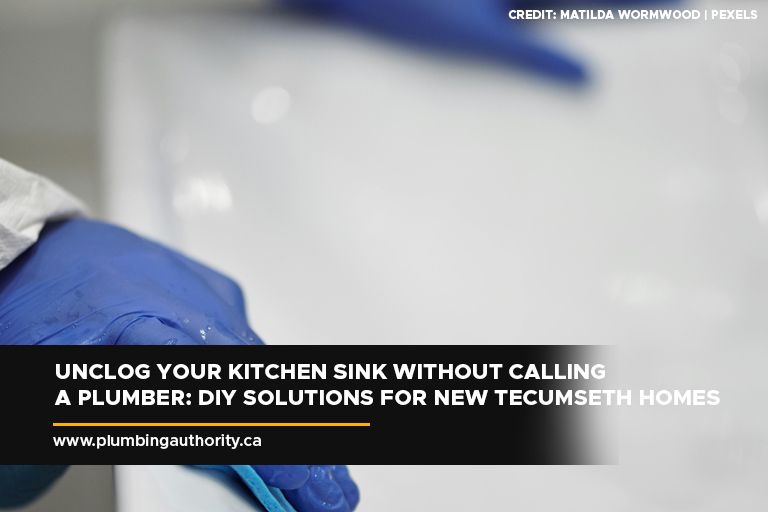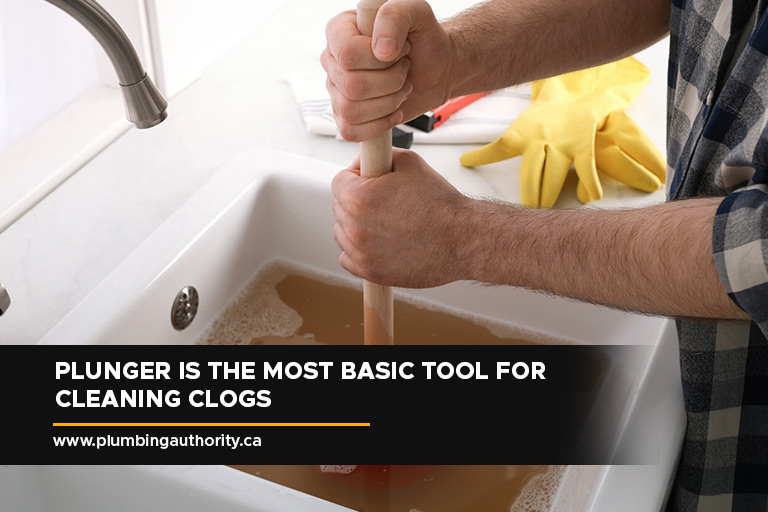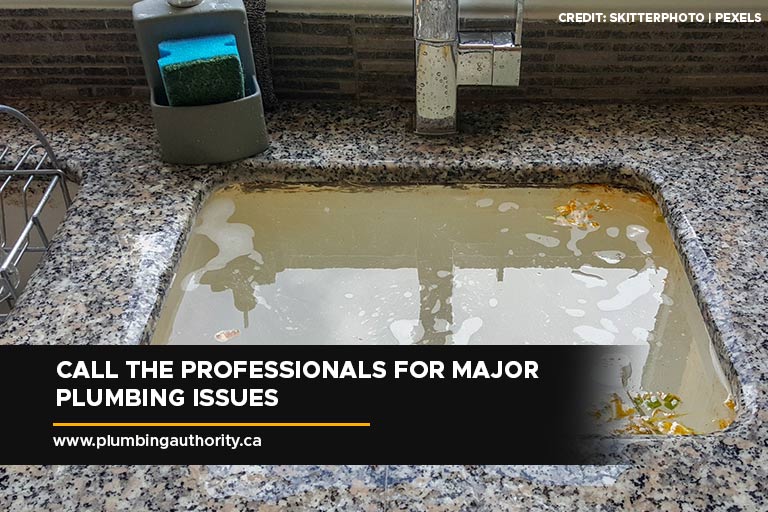
We’ve all experienced the frustration of a clogged kitchen sink. Food scraps, grease, and other debris mysteriously collect, turning your once smoothly draining sink into a stagnant pool. Before your mind races to visions of costly plumbing bills, remember— you frequently have the solutions right at home.
Most clogs are relatively minor and surprisingly easy to tackle with a few simple tools and techniques. Save yourself time and money by confidently attempting these DIY methods before calling in a professional plumber. Let’s explore the steps to get your New Tecumseth kitchen sink flowing freely again!
Before You Start
- Essential tools: Before tackling your clogged sink, assemble the following tools: a plunger designed for sinks (a flat-bottomed one), baking soda, white vinegar, dish soap, rubber gloves, and a bucket. These items are easily accessible and might already be in your home, making your DIY endeavour not only practical but also budget-friendly.
- Safety first
- Wear Protective Gear: Always wear gloves and goggles when cleaning drains to protect your skin and eyes from harmful chemicals and debris that may splash or dislodge during cleaning.
- Avoid Chemical Cleaners: Chemical drain cleaners can damage your pipes and pose health risks. Opt for natural alternatives, like baking soda and vinegar, to safely clear clogs without toxic fumes.
- Proper Ventilation: Ensure the area is well-ventilated when working on your drains to prevent inhalation of any harmful fumes, especially if you must use chemical solutions as a last resort.
- Use Tools Correctly: Familiarize yourself with how to properly use drain cleaning tools, such as plungers and plumber’s snakes, to avoid damaging your pipes or causing injury.
The Basic Methods

Plunger is the most basic tool for cleaning clogs
- Plunger
A plunger isn’t just for toilets. It can work wonders on a clogged kitchen sink too. Here’s how to use it effectively:
-
- Centre the plunger fully over the drain, ensuring a tight seal.
- Fill the sink with a few inches of water (helps create powerful suction).
- Pump vigorously up and down 15-20 times, maintaining a firm seal.
- Pull the plunger up quickly to dislodge the blockage.
- Repeat this process as needed until the drain clears.
Creating a good seal is crucial for the plunger to work effectively. If you have a double sink, seal off the other drain with a wet cloth to maximize pressure.
- Baking Soda and Vinegar
The combination of baking soda and vinegar creates a chemical reaction that can dissolve clogs. Here’s how to use this natural solution:
-
- Remove any standing water from the sink’s basin.
- Pour 1 cup of baking soda directly into the clogged drain.
- Slowly follow with 1 cup of white vinegar.
- Let the mixture sit for 10-15 minutes, fizzing and frothing as it works.
- Flush with hot water from the tap. For extra oomph, repeat!
This method leverages a natural chemical reaction that helps dissolve clogs without harming your pipes.
- Boiling Water
Boiling water can be effective for dissolving grease and food residue. However, use it with caution, especially if you have PVC pipes, as extreme heat can damage them. Pour the boiling water directly down the drain in stages, allowing the heat to work on the clog between pours.
- The Plumber’s Snake
A plumber’s snake is a flexible wire tool designed to reach deep into pipes and dislodge clogs that are beyond the reach of plungers.
-
- Insert the head of the snake into the drain.
- Turn the handle to extend the wire deeper into the pipe.
- When you feel resistance, rotate the snake against the clog.
- Pull the snake out, bringing the debris with it.
This tool requires careful handling to avoid damaging your pipes.
When to Call a Professional

Call the professionals for major plumbing issues
- Signs of a Major Clog
When tackling household plumbing issues, there’s a fine line between a manageable DIY fix and a situation that requires professional expertise. Here are signs to help you determine when it’s time to put down the tools and call in a professional plumber:
-
- Multiple Clogged Drains: If multiple drains in your home are clogged simultaneously, it may indicate a serious blockage deep within the mainline, requiring specialized equipment and expertise to resolve.
- Water Backflow: When water reverses direction and flows back into your home, it can pose significant health risks. This issue typically signifies a problem with the backflow prevention device that only a professional can address.
- Persistent Bad Odours: Continuous foul odours emanating from your drains might be a sign of a deeper issue, such as a broken vent or sewer pipe. A professional plumber can diagnose and repair the underlying cause.
- No Water: A complete lack of water in your home could be due to various reasons, including major blockages or supply problems. Professionals can quickly identify and solve these complex issues.
- Frozen Pipes: Attempting to thaw frozen pipes on your own can lead to cracks or bursts. Plumbers have the necessary tools to safely thaw and repair pipes, preventing extensive water damage.
- Low Water Pressure Throughout the House: If you’re experiencing consistently low water pressure in multiple areas, there could be a significant issue with your main line or water supply that requires professional diagnosis and repair.
- Limitations of DIY
Tackling home improvement projects yourself can be rewarding and cost-effective. However, DIY solutions have their limitations, especially when it comes to complex or specialized tasks. Here are some limitations of DIY to consider before starting your next project:
-
- Lack of Expertise: DIY enthusiasts often lack the specialized knowledge and experience that professionals possess, which can lead to mistakes, inefficiencies, or incomplete projects that don’t meet safety and quality standards.
- Safety Risks: Without proper training and equipment, attempting certain tasks can pose significant safety risks. Electrical work, plumbing, and structural modifications can lead to injury or property damage if not handled correctly.
- Time Consumption: DIY projects can consume much more time than anticipated, especially for those learning as they go. This time investment can disrupt daily life and may not always be worth the potential savings.
- Tool and Material Limitations: Professionals have access to high-quality tools and materials that may not be economically feasible for one-time DIY projects. The use of inferior products can affect the durability and finish of the project.
- Permits and Regulations: Many homeowners are unaware of the local codes and permits required for certain home improvement projects. DIY work done without the necessary approvals can lead to fines, legal issues, and problems when selling your home.
Don’t let a clogged kitchen sink dampen your spirits. Empower yourself with these DIY solutions. Feeling out of your depth or if the clog won’t budge? Don’t hesitate to call a reliable plumber. For expert assistance in New Tecumseth, contact Plumbing Authority at (647) 992-7473.




